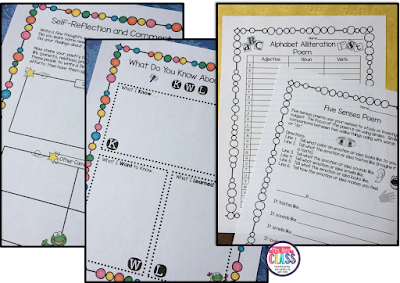Poetry should be fun for students and it's our job as teachers to help students love the sound of written language. We model our passion through our lessons, memories from our childhood, and our enthusiasm. I remember my dad reciting Lewis Carroll's "The Walrus and the Carpenter" word for word...the whole thing! I was amazed and it soon became a poem I could recite and fall in love with as well. My students were amazed that I, too, could recite much of the poem from memory.
Here are some tips to get you started teaching poetry in your classroom!
Tip #1: Start by reading your own favorite poem to students. It helps them see that you enjoy poetry, and that they, too, can enjoy poetry. If you don't have a favorite, Shel Silverstein is great poet to begin with, because 4th graders love the humor and can relate to the poems. Make sure to read the poem with great intonation and emotion. It will really hook them. When you've finished reading the poem, talk about the mood, the speaker in the poem, the setting and the problem in the poem. Then you can challenge students to find the figurative language. Once you've done all of this, re-read the poem so your students can see the poem from a whole new perspective.
Not sure which poems to read? Here is a list of some of my favorite poems:
"Sick" by Shel Silverstein
"Sarah Cynthia Silvia Stout" by Shel Silverstein
"The Giving Tree" by Shel Silverstein
"Paul Revere's Ride" by Henry Wadsworth Longfellow
"The Walrus and the Carpenter" by Lewis Carroll
"Sneezles" by A.A. Milne
"The Owl and the Pussycat" by Edward Lear
"Wynken, Blyken, and Nod" by Eugene Field
"Twinkle, Twinkle Little Star" by Jane Taylor
Tip #3: Introduce different forms of poems. This allows you to teach about the rules of poetry. For example: Haikus have a very specific 5, 7, 5 syllable rule that must be followed, while other poems simply use rhyming words, while others have no form at all. Challenge students to find the rule that is followed within each poem.
Tip #4: Introduce the vocabulary of poetry. This will really help students understand what they are reading and learning about. Try using an interactive notebook to engage kids even more. If you are searching for something to get you started, check out this interactive notebook of figurative language. Students also love reference posters that are posted on a word wall for easy reference. Last but not least, let students play a game to learn the vocabulary of poetry. Students don''t even realize how much they are learning when they see how fun Cootie Catcher Vocab is!!
Tip #5: Let students try their hand at writing poetry! I know it sounds crazy, but you will be surprised. Give students the reins, and let them write about whatever interests them. I think you will be surprised at how much students take ownership of writing poems, and find their own style, even the boys! Not sure where to start? This 6 week poetry unit gives you all that you need to introduce poetry writing, guidelines, templates, poetry outlines, templates, and so much more!
Tip #6: Let students make their very own book of poems! Take all of the poems they have written, and compile them into their very own poetry book. Let students design their own book cover, or give them a template to color in. Challenge students to write an about the author page (who knew you could sneak in a little teaching about autobiographies too). At the end of the unit, have students share their poetry book with family and friends, and have them write comments in the students poetry book! The feedback will encourage them that their written thoughts have power and value. My daughter was in my 4/5 blend class and still has the poetry book she wrote. It's a real keepsake that shows her interests at the time.
Tip #7: Once students have listened to you read poetry aloud, read poetry, and tried their hand at writing poetry, they are armed with the skills necessary to dig even deeper and begin analyzing poetry. Poetry centers work great for poetry analysis. At each center, give students task cards to complete to guide and challenge their learning. With structure and teaching the elements of poetry, students will soon enjoy the detective work needed to understand the deeper meanings of some poems. There are nine poems on the CCSS-ELA Exempla list for 4th and 5th graders, which is a great place to start your poetry analysis. Remember, part of analyzing poetry is learning about the poet and his/her life and learning about the time period. If you're not sure where to start, here is a great Task Card Bundle.
Love poetry!















